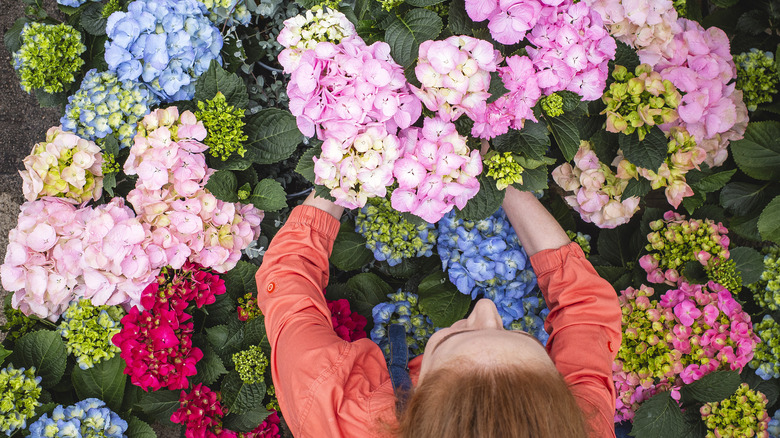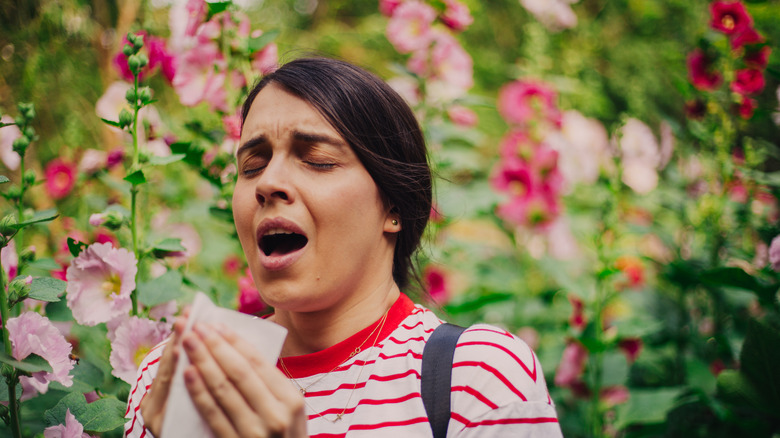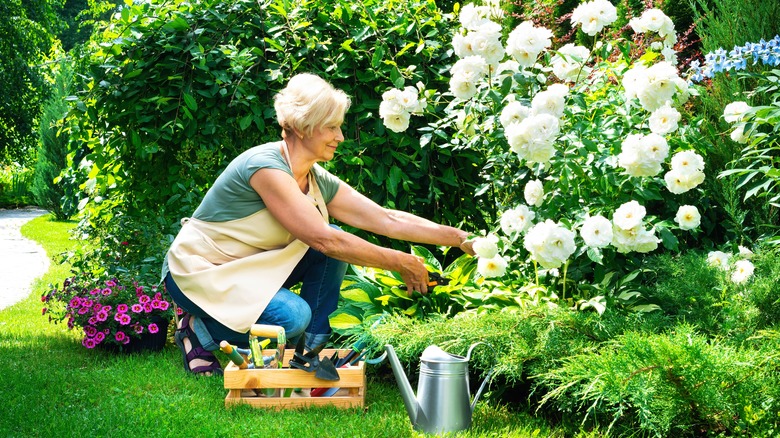Hydrangeas Have A Hidden Benefit That Makes Them Perfect For Allergy-Free Gardens
If you dread the spring and fall for all the pain and sniffles they bring, you are not alone. Many people are allergic to pollen, and they might be unsure how to mitigate the negative allergy symptoms. Luckily, just like there are ways to make your home a haven if you have seasonal allergies, there are also ways to do so in your garden. Furthermore, these ideas will still allow you to enjoy the beauty that plants can bring to your outdoor space. One solution is to plant the right kinds of flowers, and hydrangeas are an ideal choice. This is because they usually produce less pollen when compared to other types, and their pollen tends to be on the stickier side.
Seasonal allergies can be triggered by things such as flowers, trees, grass, and other plants. Pollen allergies take place when your body's defenses produce histamines to fight off what it thinks is dangerous to your system. It's that defense mechanism that causes the uncomfortable sniffling, sneezing, and watery eyes. Pollen content in the air is typically high on warm, dry, or windy days, but hydrangeas' pollen has characteristics that makes it less likely to become airborne even in these conditions. Find out more about why hydrangeas are great for those with seasonal allergies and how to incorporate them into your allergy-free garden.
Why hydrangeas are a great choice if you suffer from allergies
The sticky nature of hydrangeas' pollen is what makes it so great for allergy sufferers. Even in windy conditions, it's less likely to become airborne and irritate your sinuses. Furthermore, the large flowers on hydrangeas are actually sterile and don't produce any pollen; their function is to draw in pollinators. Instead, their fertile flower parts are quite small and don't contain much pollen.
Additionally, while spring and fall tend to be the times of year when allergies are at an all-time high, many hydrangeas bloom in the summer, meaning that they can avoid the additional pollen production that happens in the peak seasons. Therefore, their small amount of pollen won't contribute to your seasonal allergies during these times of year. Hydrangeas also typically don't give off a potent scent like those produced by other flowers. This is beneficial for certain people because these strong fragrances can become highly concentrated on warmer days or in smaller spaces and cause headaches. Instead, hydrangeas' mild smell and lack of pollen shouldn't make your allergy symptoms worse.
Creating your allergy-free garden
Hydrangeas, which come in many colors like white, pink, blue, and purple, can be planted in spring or fall. Depending on the types of hydrangeas you choose, you could plant them in USDA zones 3 through 9. You can also plant hydrangeas like the summer crush variety in your smaller spaces or indoors, since they can do well in containers. While these flowers tend to be low-maintenance, ensure you plant your flowers where they can get a good amount of morning sun and avoid exposure to harsh afternoon sun. They need about an inch of water per week, but flowers planted indoors in containers usually dry quicker and may need a little more irrigation.
If you're looking to complement your hydrangeas, consider pairing them with other flowers that will also be kind to your allergies like tulips, daffodils, and petunias. Versatile plants like rosemary offer beauty and function to your space, since you can enjoy the lovely and mild aroma from the white and purple flowers and also use it in many recipes in the kitchen. Hostas, cacti, and bird of paradise plants will bring a unique look into your garden and aren't wind pollinated. If you deal with allergies, avoid daisies, wisteria vines, and sunflowers, which contain lots of pollen. Additionally, wind pollinated plants and flowers like ornamental grasses and amaranth are particularly harmful because their pollen is airborne.


